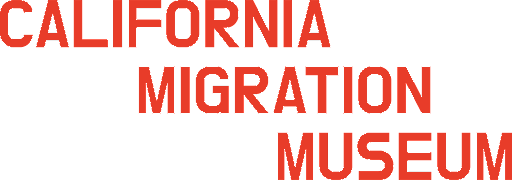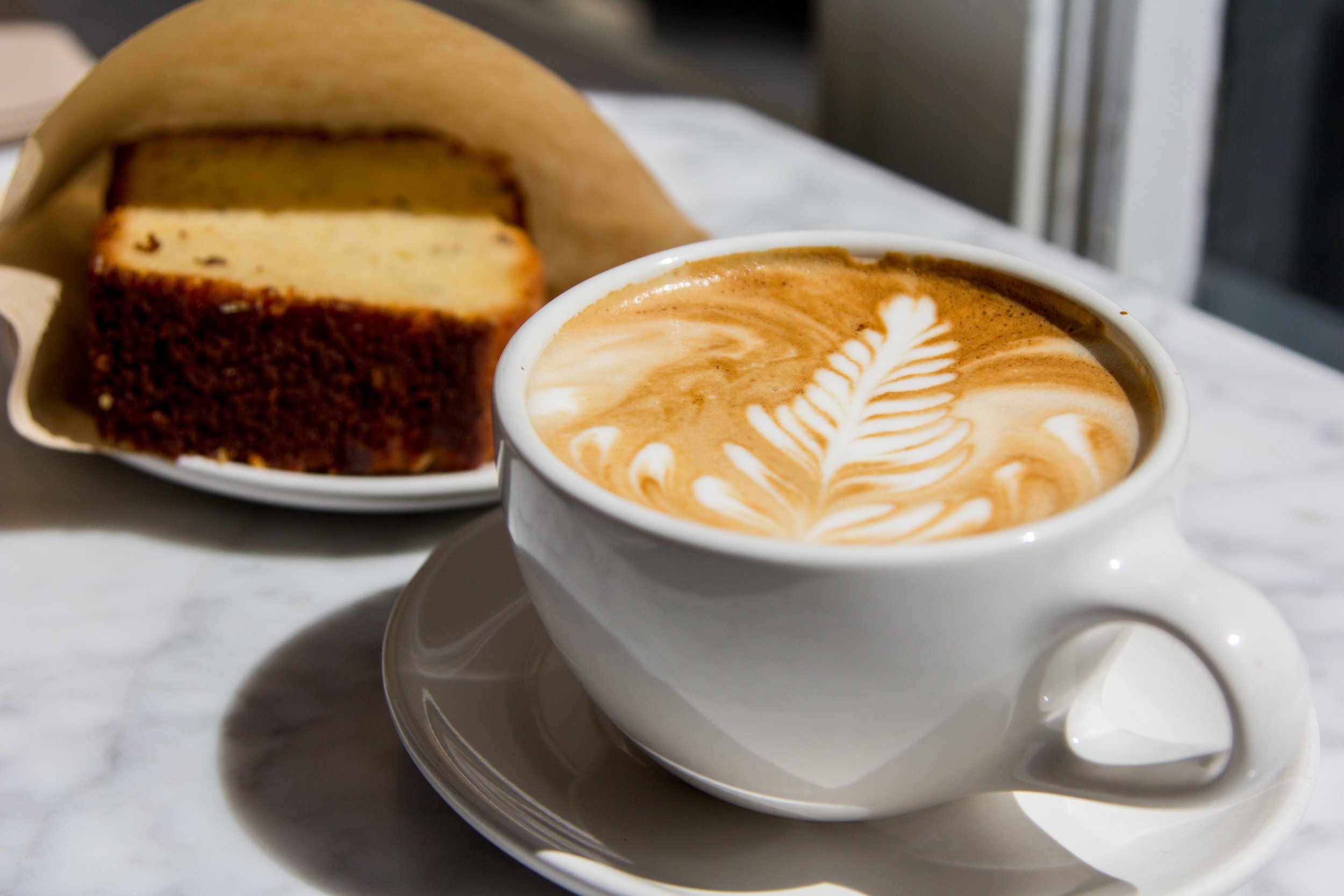Coffee Waves
Coffee City
Credit: Gary’ CC by ND 2.0
If you want to try and understand 21st century San Francisco, coffee is a good place to start. San Franciscans will spend hours debating where to get the best coffee, and the most famous roasters are household names: Andytown, Sightglass, Ritual, Blue Bottle. Here, every cappuccino comes with an origin story, served by a tattooed barista in a glass-and-steel temple to caffeine. All this expensive minimalism reflects a moneyed, MacBook-toting San Francisco back upon itself, though it’s not always clear whether the customers look too closely in the mirror. But there’s much more to San Francisco’s coffee story than this. As we hear in Coffee Country, the story goes back centuries.
First Wave Coffee: Cash Crop Caffeine
Hill Bros Coffee HQ in San Francisco: the building is still recognizable today. Credit: Dale Cruse, CC BY 2.0 DEED
After the Boston Tea Party in 1773, American patriots drank coffee. But it wasn’t until 1850 – the same year California became the 31st state in the US – that the first American coffee company was founded. Pioneer Steam Coffee and Spice Mills took advantage of the market created by the Gold Rush migration to commercialize and mass market coffee to prospectors looking for the hit of caffeine without having to spend time roasting their own green beans. We know Pioneer Steam Coffee today as Folgers. For 19th century Americans, a hot cup of coffee was a quick and affordable pick-me-up. Coffee wasn’t about taste or flavor. This meant that in turn the economics of coffee weren’t about quality: profits were about the quantity of coffee sold.
Hills Bros coffee was also founded in San Francisco, opening its first retail store in 1882 on Fourth Street under the name Arabian Coffee & Spice Mills. From 1900, Hills Bros were the first company to sell vacuum-packed roast coffee, As we hear in Coffee Country, Hills Bros also pioneered the idea of “cup tastings”: choosing beans based on the taste rather than simply appearance. By the 1920s, coffee was San Francisco’s largest industry, with merchants buying a Million bags of Central American coffee a year. In 1926 Hills Bros moved their operations to a landmark headquarters on the Embarcadero: the company’s sign is still visible on the building today.
The San Francisco coffee trade was closely tied to Central America, and especially El Salvador. World War I had disrupted European imports, offering an opportunity for the city to solidify its hold over the coffee trade. The Pacific Mail Steamship company, based in San Francisco, offered to transport Salvadoran coffee for free, paying Central American growers directly in order to control their shipments. For El Salvador – the only Central American country without no Caribbean coastline – this Pacific trade route was particularly important.
Hills Bros fuelled demand for Salvadoran coffee, and collaborated with James Hill (no relation) and other Salvadoran coffee oligarchs to fuel the development of a commodified cash-crop industry, in which both company profits and a political regime were built on the back of violent exploitation of El Salvador’s landless peasants. But the human costs of Salvadoran-grown coffee was largely invisible to consumers in San Francisco and the wider United States – as we see in Coffee Country, Hills Bros presented its operations in El Salvador as peaceful and bucolic, ignoring the blood spilled in 1932 in La Matanza.
Hills Bros red can was instantly recognizable to American consumers in the first half of the 20th century
Second Wave: Quality Control
Original Starbucks Market Store, Seattle c.1977, Seattle Municipal Archives CC by 2.0
In the 1960s, the Bay Area was at the center of not only a cultural but a coffee revolution. In 1966 Peet’s Coffee opened in Berkeley, California, hand-roasting coffee beans in small batches. Appalled at the “mud” most Americans drank when they brewed coffee, Alfred Peet, was focused upon bringing high-quality coffee to the US. His dark-roasted beans were a hit, and he quickly became known as the “Godfather of Gourmet Coffee”. Five years later, in 1971, the first Starbucks coffee house opened in 1971. It sold beans roasted by Peet, who acted as a mentor to the company’s founders. In 1984, Starbucks bought Peet’s for $3.8m. Three years later, Starbucks was sold to a group of investors, including Howard Schulz. The second era of “big coffee” had arrived.
Although Peet’s main focus – and the main drive of the second-wave coffee revolution – was selling better-quality coffee to consumers, this led in turn to an increased interest in sourcing high-quality beans, and introduced the idea of coffee having a “country of origin”, rather than simply being a generic crop. In countries of production, the second wave coffee movement helped to foster new conversations with farmers and communities about opportunities to grow higher quality coffee that would fetch higher prices. This ethos also reflected the concerns of the nascent farm-to-table and ecology movements, both of which were also strongly rooted in 1970s Berkeley and the wider Bay Area.
However El Salvador did not benefit from the Second Wave coffee movement. Land inequities and the many decades of monoculture meant that there were relatively few small coffee farmers. Instead, El Salvador’s oligarchs continued to grow their beans for large corporations like Folger and Maxwell House, prioritizing quantity over quality. Over the next two decades, political instability and Civil War would further devastate the country’s coffee economy.
Peet’s Coffee “Design of Coffee” Class at UC Davis builds on the techniques developed in the 1960s Second Wave Coffee movement to teach students about origin and roast. Credit: UC Davis College of Engineering, CC BY 2.0
Third Wave Coffee: Art and Craft
Steve Ford, Ritual's roaster and buyer, checking on beans in the sample roaster. Credit: Niall Kennedy, CC BY NC 2.0
Second wave coffee was better coffee, but it soon became Big Coffee. In 2012, Peets was sold to private equity buyers for nearly $1 billion. By 1992, when it floated on the stock market, Starbucks was worth $270 million, and today Starbucks is a $125 billion dollar company.
This rise in value was the result of a global expansion strategy. However Starbucks was heavily criticized by many anti-globalization activists, who argue that Starbucks chose to operate at a loss when expanding into new markets in order to displace local stores. Starbucks has also been accused of tax avoidance and union busting. As we see in Coffee Country, Starbucks coffee cups, like McDonalds golden arches, have become an instantly recognizable symbol of global capitalism and its often corrosive effects on local communities.
Third Wave coffee emerged partly as a response to this corporate strategy. Small, independent coffee shops rejected the goal of corporate expansion, presenting themselves as community-centered and often running on a co-operative model. This hyper-local approach was also reflected in the way coffee was made. Coffee started to resemble the craft movements of beer and whisky, with customers interested in the farm processes, the sustainability of the supply chain, and exactly how the coffee was roasted. While Second Wave coffee had introduced the idea of a “country of origin”, Third Wave coffee makers now talked about individual farms and even growers.
Four Barrels Coffee for sale, in the Mission District. Credit: Niall Kennedy, CC BY NC 2.0
As part of the Third Wave coffee movement, consumers were encouraged to become educated about the politics of coffee production, increasing demand for Fairtrade and RainForest Alliance-certified blends. These certifications help to verify fair-trade practices and create sustainable supply chains, although in the past decade there has been increasing skepticism about the degree to which these official labels are used to “greenwash” coffee rather than leading to sustained changes to the way coffee is produced and sold.
Once again, San Francisco was again at the center of the shift to Third Wave coffee. If you walk into an artisanal coffee shop in the Mission today – such as Sightglass or Four Barrel – you’ll see Third Wave coffee in action. And you’ll pay a Third Wave price. Charging $5 for an espresso or $7 for a latte is not uncommon in 2023 – meaning that for many Mission residents, Third Wave coffee can feel culturally intimidating – as well as being unaffordable.
In El Salvador, the post-conflict coffee industry has continued to face major challenges. Despite a shift towards producing more high-end quality coffee beans, annual coffee exports from El Salvador fell from 330,000 tonnes in 2000 to just 75,000 tonnes in 2018, after coffee rust fungus infected 75% of El Salvador’s coffee plants. Climate change is likely to exacerbate this Coffee crisis, as more frequent tropical storms bring intense humidity that allows the rust fungus to flourish.
In 2020, another wave of rust infections helped fuel a new Central American migration crisis at the US border, as coffee workers unable to feed their families moved north.
A Fourth Wave?
Coffee analysts have been heralding the arrival of Fourth Wave coffee for many years – but it’s not clear whether the Fourth Wave has arrived yet – or what exactly Fourth Wave coffee even means. Some observers argue that Fourth Wave coffee will be characterized by new concern for workers’ rights, and prioritize ownership of coffee shops and roasteries by groups that have historically been on the margins of coffee production, such as women and people of color. Others point to the need for more transparency on pricing and profits, trying to make speciality coffee something that can be accessed by every resident of neighborhoods like the Mission, not just those making Professional salaries.
Still others suggest that the Fourth Wave may arrive outside the United States. Today, only 10% of coffee grown in El Salvador is consumed domestically, but a concerted effort is being made to try and blur the gap between coffee production and coffee consumption, so that speciality coffee is drunk in places like El Salvador – rather than just exported for white, Western consumers. In many ways, this change could end up being the most radical shift since beans first started being unloaded on San Francisco’s piers 170 years ago, black gold arriving in the quintessential Gold Rush city.
Credit: Scott Beale / Laughing Squid
Want to Learn More?
Coffeeland, Augustine Sedgewick
Uncommon Grounds: the History of Coffee and How it Changed our World, Mark Prendergrast
The Fourth Wave of Coffee is… not coming, Ashley Rodriguez








